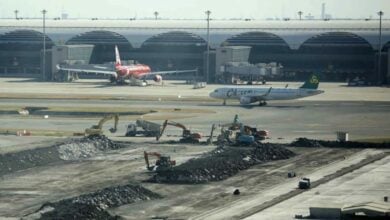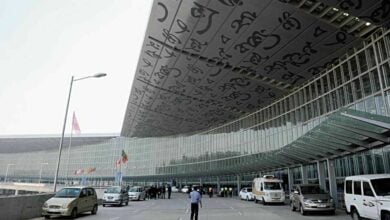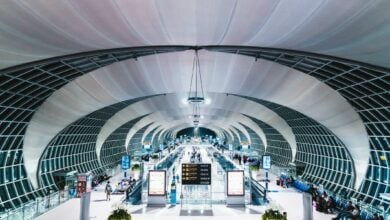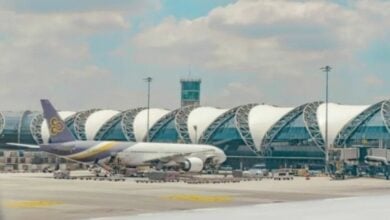World News
Explore the latest global news with The Thaiger’s World News page, your comprehensive source for international updates. We’ve got breaking news, insightful analysis, and exclusive stories from around the globe, covering politics, business, technology, and culture. Stay informed about the world’s most pressing issues, emerging trends, and influential events, as well as updates on travel, lifestyle, and entertainment.
The Thaiger is your go-to platform for staying connected with the ever-changing world we live in. To keep up with the most reliable international news source, subscribe to our newsletter and follow us on social media.
-
 Sponsored
Sponsored National Family Health History Day: Know your risks, protect your family
November 28 is National Family Health History Day, a time dedicated to understanding how your family's medical history shapes your own health and future. Established in 2004 by the U.S. Surgeon General, this day encourages families to gather, discuss, and...
-

Thai airlines offer 30% discounts on 50,000 seats for new year
The Thai Ministry of Transport announced a new year’s gift for travellers, addressing the issue of expensive flight tickets by collaborating with airlines to offer a 30% discount on 50,000 seats during the new year holiday period. Deputy Prime Minister and Minister of Transport, Suriya Jungrungreangkit yesterday, November 27, disclosed that a meeting was convened with the Thai Airline Association.…
-

Billionaire’s heir shuns US$5bn fortune for life as forest monk
In a tale that sounds straight out of a spiritual bestseller, Ajahn Siripanyo, the only son of Malaysian billionaire Ananda Krishnan, turned his back on a US$5 billion inheritance to pursue the humble life of a Buddhist monk. Ananda, one of Malaysia’s richest tycoons, oversees a sprawling empire that includes telecom, satellites, oil, real estate, and media. Yet his son,…
-

Netflix star smuggles her way out of jail despite £150k cannabis bust (video)
In a sensational twist right out of a crime thriller, Netflix star Olga Bednarska incredibly escaped a long prison sentence despite being nabbed at Manchester Airport smuggling cannabis worth £150,000 (6.75 million baht) through customs. The star of Netflix’s hit reality show Too Hot to Handle, found herself entangled in a scandalous drug-smuggling affair after Manchester Airport customs officers intercepted…
-

AoT to compensate residents 12 billion baht for airport noise
Airports of Thailand (AoT) is set to distribute 12 billion baht as compensation to residents affected by noise pollution from the third runway at Suvarnabhumi Airport. This decision follows a meeting held on Monday, November 25 involving the AoT, the Transport Ministry, and the Bangkok Metropolitan Administration (BMA) to address residents’ demands for relief from the noise generated by aircraft…
-

India launches new flights to Bangkok and Kuala Lumpur this winter
International travel from India’s Kolkata is in for a major lift this winter, as two major airlines ramp up connections to Southeast Asia. With Thai Lion Air launching four weekly flights to Bangkok and Malaysia Airlines resuming its pre-pandemic route to Kuala Lumpur, Kolkata travellers are set for a world of new options. Starting December 16, Thai Lion Air, a…
-

Thai star stuns Hollywood with historic Emmy win (video)
Thai actress Chutimon Chuengcharoensukying, also known as Aokbab, dazzled New York by winning the Best Performance Emmy for her outstanding role in Netflix’s Hunger. Thai cinema’s new leading lady is bringing more than just street food to the table. Aokbab secured the prestigious Best Performance by an Actress award at the 52nd International Emmy Awards in New York City. Her…
-

Thai man arrested at Bangkok airport for baht luxury bag scam
Police at Suvarnabhumi Airport apprehended a 36 year old Thai man attempting to flee the country after allegedly scamming several individuals out of over 100 million baht through the sale of counterfeit luxury brand bags. Thanawat’s arrest was executed by immigration police at the airport in Bang Phli, Samut Prakan, at 5pm yesterday, November 25. The arrest warrant had been…
-

Boy 7 killed by Thai mother rocks quiet Welsh town
Police in Wales reported that the death of a 7 year old boy at the hands of his Thai mother has rocked the quiet Welsh town of Haverfordwest. Seven year old Louis Linse was found dead in his bed, his life tragically cut short by his mother. Thai-born Papaipit Linse admitted to manslaughter by diminished responsibility, a truth that unravels…
-

Airline satisfaction steady, tech investment urged by IATA
Airline passenger satisfaction has maintained a high level of stability this year, according to findings from the International Air Transport Association (IATA). Despite this consistency, the association has highlighted the need for further investment in technology to better meet customer demands. Insights from IATA’s Global Passenger Survey 2024, based on feedback from over 10,000 respondents across 200 countries, revealed that…
-

British tourist dodges death after toxic night at Laos hostel (video)
A British tourist revealed her narrow escape from death after a night out at a notorious Laos hostel turned into a near-fatal encounter with methanol poisoning. This same party spot has become infamous following the tragic deaths of six other holidaymakers, casting a dark shadow over Vang Viang, a village once famed for its boisterous backpacker scene. The unfortunate casualties…
-

Don Mueang: Fake bomb threat on flight to Hat Yai causes chaos
A foreign national was arrested after making a fake bomb threat on a flight bound for Hat Yai, causing chaos for passengers and staff. The individual claimed stress from family issues as his motivation, leading to significant disruption. Security at Don Mueang Airport was alerted when a call was received, warning of a bomb on a flight to Hat Yai.…
-

Man busted in UK smuggling cannabis from Thailand to clear debt
A down-and-out drug mule took a gamble to clear his debt to his own mother – and lost big-time at Manchester Airport. Dean Pharoah, who owed cash to his mum, tried to smuggle over £200,000 (approximately 8 million baht) worth of cannabis into the UK after a holiday in Thailand. But UK Border Force officers had their suspicions and swooped…
-

Thai worker abandoned in Israel after hospital discharge (video)
A Thai worker in Israel who, after being discharged from the hospital, found himself abandoned by his employer at a workers’ camp. The man, unable to recall any personal details, has since disappeared from his accommodation, leaving both his family and fellow workers anxious for his wellbeing. A TikTok user, identified as @jacaky2538, who is also a Thai worker in…
-

Thai Lion Air eyes new route to boost Nakhon Phanom tourism
Thai Lion Air is contemplating expanding its flight operations to Nakhon Phanom, in line with the Thai government’s strategy to boost tourism in lesser-known cities. This move is part of an initiative to transform secondary tourism cities into bustling hubs. Deputy Transport Minister Manaporn Charoensri has tasked the Department of Airports (DoA) with exploring avenues to increase flight frequency to…
-

British lawyer latest to fall in Laos alcohol poisoning tragedy
A British lawyer has become the latest fatality of alcoholic poisoning in Laos taking the death toll to five people. The chilling incident has sent shockwaves across the globe. The British lawyer Simone White is the tragic fifth victim in a series of suspected mass poisonings in Laos, Southeast Asia. A UK Foreign Office spokesperson grieved alongside her family, confirming…
-

Bangkok Airways employs French jets to support tourist surge
As Thailand’s tourist influx hits an all-time high, Bangkok Airways is scrambling to keep up, turning to France for reinforcements. In a bid to tackle its aircraft shortage, Bangkok Airways (PG, Bangkok Suvarnabhumi) has secured a wet-lease deal with French airline Amelia (8R, Paris Le Bourget), which will provide two Airbus narrowbody aircraft to support the Thai carrier’s operations over…
-

Aussie teen dies in Bangkok after Laos poisoning, 4 dead
One of the Melbourne teenagers on an idyllic backpacking adventure in Asia has died in a Bangkok hospital from a suspected methanol poisoning incident in Laos. Bianca Jones, a 19 year old Australian tourist, became the latest person to die from a suspected methanol poisoning incident in Laos after drinking vodka shots. The Aussie teen’s death is the fourth in…
-

Flight chaos: Air India passengers twice-stranded in Phuket
Over 100 passengers on an Air India flight to New Delhi found themselves stranded in Phuket for over 80 hours, enduring a string of delays due to persistent technical issues with their aircraft. The saga began when the flight, initially scheduled for departure on the night of November 16, was postponed by six hours, with the airline citing technical faults…
-

Pichai spices up the US: 50 influencers back authentic Thai food
Commerce Minister Pichai Naripthaphan has enlisted the help of 50 powerful US influencers to promote a wave of authentic Thai restaurants across the US. The star-studded event took place in Hollywood, California, where Pichai awarded prestigious Thai Select certificates to seven US-based Thai restaurants. The 6pm ceremony, yesterday, November 19, which was broadcast live on social media by influencers with…
-

THAI to fly wide-body jets on domestic routes this December
In a move that’s sure to delight frequent flyers, Thai Airways (THAI) revealed plans to swap its trusty A320s for luxurious wide-bodied aircraft on select domestic routes this December, just in time for the peak holiday season. The airline is ramping up capacity to accommodate the soaring demand during the Christmas-to-new year rush, from December 20 to 31. While official…
-

Thai smile, Roman style: New Italy-Thailand flight to boost tourism
Thailand just got a little closer to Italy. The inaugural ITA Airways direct flight from Rome to Bangkok touched down at Suvarnabhumi Airport, marking the beginning of a new era for tourism and business travel between the two countries. This direct route, running five times a week, offers Italian travellers a smoother journey to Thailand’s famous beaches, cultural sites, and…
-

Airlines to add 73,000 seats for new year travel in Thailand
Six airlines are set to increase their seat offerings by over 73,000 during the new year period to prevent excessive price hikes during the festive season. This effort, led by the Transport Ministry, involves collaboration with Thai Airways International and other members of the Airlines Association of Thailand (AAT), including Bangkok Airways, Thai AirAsia, Nok Air, Thai Lion Air, and…
-

Thailand airports to rival global top 20 within five years, says AoT
Thailand’s major airports are set for a significant transformation as Airports of Thailand (AoT) aims to elevate them into the top 20 globally within five years, drawing inspiration from Singapore’s renowned Changi Airport. This ambitious plan, spearheaded by the Transport Ministry, targets Suvarnabhumi International Airport as a key player in achieving this goal. Permanent Secretary for Transport, Chayatan Phromsorn, confirmed…
-

High ambitions: Suvarnabhumi aims to triple transit traffic by 2030
Suvarnabhumi Airport, Thailand’s busiest international gateway, is gearing up for a major transformation to become Southeast Asia’s ultimate transit hub. Airports of Thailand (AOT) plans to raise the airport’s transit flights from a mere 4% to a soaring 20% as part of an ambitious master plan to rank among the world’s top 20 airports by 2030. This bold goal is…
-

Naked intruder found living under Los Angeles home for six months
A woman discovered an unexpected intruder living beneath her Los Angeles home for approximately six months. The 93 year old found a naked man hiding in a small underground space, prompting police intervention to remove him. Despite efforts involving police dogs and tear gas, the man resisted leaving. Police identified the man as 27 year old Isaac Betancourt, who was…
-

Suvarnabhumi soars as UNESCO’s most beautiful airport (video)
In a triumph for Thai architecture, Suvarnabhumi International Airport has been hailed by UNESCO as one of the top six most beautiful airports globally for 2024. But that’s not all, the airport’s SAT-1 building has also bagged a nomination for the prestigious Prix Versailles Award for the most stunning airport design on the planet, with results set to be revealed…
-

Trump’s win sparks PM Paetongtarn’s bold investor push
Thai Prime Minister Paetongtarn Shinawatra is seizing the momentum after Donald Trump’s election victory by calling for an ambitious strategy to attract foreign investors to Thailand. Speaking in Los Angeles yesterday, November 12, to Thai ambassadors, consul-generals, and key representatives of Team Thailand from across the Americas, the Thai premier urged diplomats to become a front-line force, promoting Thailand as…
-

Thai Airways joins backlash against Rolls-Royce delays
Thai Airways (THAI) is fed up with Rolls-Royce, joining a growing backlash over delays in jet engine maintenance that’s forcing its fleet into prolonged downtime. CEO Chai Eamsiri has revealed that the airline’s Boeing 787 Dreamliners are now waiting up to 120 days for engine maintenance, a stark increase from the previous 90-day standard—a time frame he already considered frustrating.…
-

Suvarnabhumi Airport to offer early check-in by February
Suvarnabhumi International Airport is set to introduce an early check-in service, allowing passengers to complete their check-in process up to 24 hours before departure. This initiative, announced on the Transport Ministry’s social media platform, is aimed at enhancing traveller convenience and reducing congestion at Thailand’s primary international gateway. Airports of Thailand (AoT) President Kerati Kijmanawat indicated that the service is…
-

Pilotless ‘air taxis’ takes first flights above Bangkok (video)
Chinese aviation tech company EHang made history by launching its EH216-S pilotless electric vertical take-off and landing (eVTOL) aircraft in Thailand. The debut passenger flights, held at the Thailand Drone Exhibition & Symposium 2024, mark a major milestone as Thailand becomes the 18th country to host EHang’s futuristic eVTOL flights. With the Civil Aviation Authority of Thailand (CAAT) leading the…
Broke? Find employment in Southeast Asia with JobCute Thailand and SmartJob Indonesia. Rich? Invest in real estate across Asia with FazWaz Property Group or get out on a yacht anywhere with Boatcrowd. Even book medical procedures worldwide with MyMediTravel, all powered by DB Ventures.






























